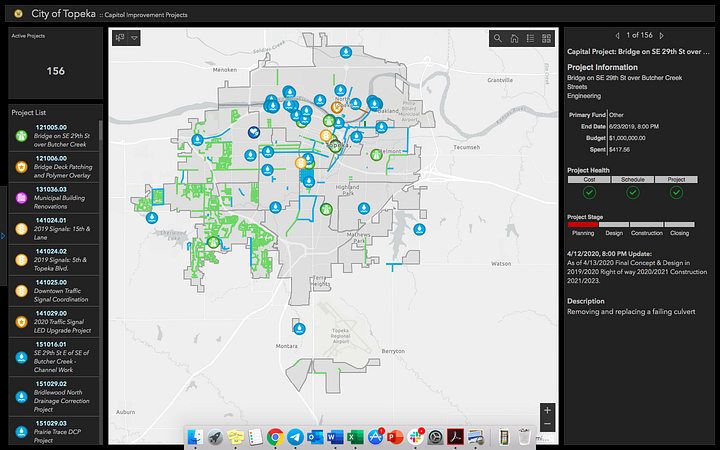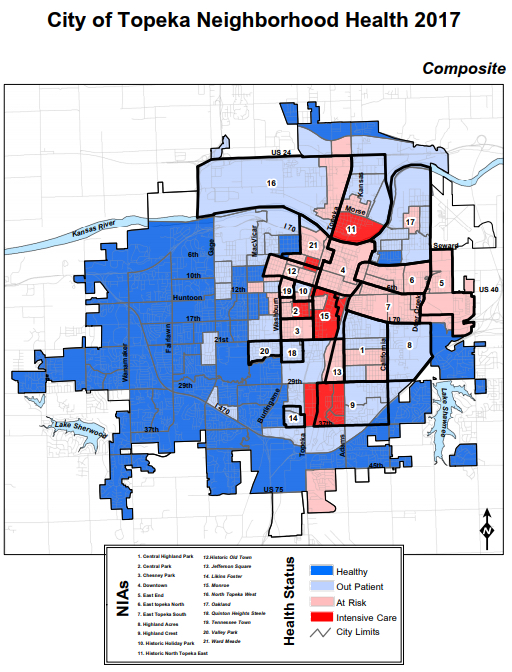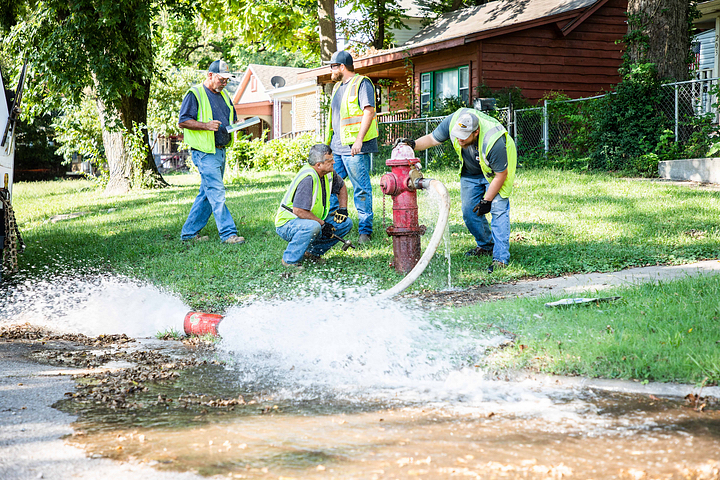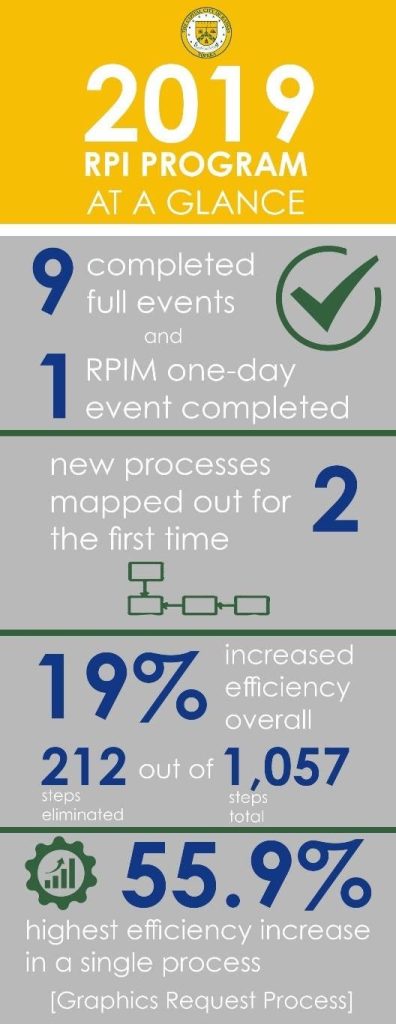Topeka, Kansas, USA
Transparency, Engagement, and Results in Topeka.
Project Type:
Community Engagement, Communications, High-Performing Government, Infrastructure, Transportation
At a Glance
Launched a series of interactive datasets and maps for residents to track the city’s budget and capital improvement projects, promoting accountability and transparency.
Produced video tutorials and how-to guides to help residents understand and use the city’s new open data portals, encouraging public engagement and input.
Created a scoring index to measure the quality of every paved street in Topeka in order to prioritize street improvement projects and develop a cost-effective infrastructure improvement plan.
Topeka’s Not Afraid to Connect
If you had walked through the doors of Topeka City Hall earlier this year, a bright green and yellow banner would have greeted you with an engaging question: “How would you spend $96.5 million of the City of Topeka’s money?” The banner, jointly created by the city’s Administrative & Financial Services Department and Department of Neighborhood Relations, was posted in city administrative buildings downtown and invites people to visit the city’s performance portal to “Hold us accountable!” and “Track how we are measuring up.”

It’s a high-visibility tactic to pull residents into the 2021 budget engagement process in Topeka, which sits along the Kansas River in the state’s northeast corner. The banner also signifies the capital city’s commitment to performance, transparency, and community engagement — all of which city officials see as crucial for building trust, meeting the needs of about 125,000 residents, and spending tax dollars efficiently.
A User-Friendly Foundation
Just a few years ago, Topeka’s government wasn’t nearly as open to its residents. The data revolution that spread across the country during the 2010’s changed that: city leaders committed to increasing access to data inside and outside of City Hall. And they started engaging the community to solve problems.
“The goal was and is to provide the public with greater access to city data and opportunities to work collaboratively on complex challenges facing our community. By increasing the city’s accountability, we were building trust with residents and changing the way the city operates.”
The launch of Topeka’s open budget portal in 2015 marked a turning point. For the first time, residents could access datasets that showed, down to the line item, how the City aimed to spend their tax dollars. The City released its 2016 budget on the same portal, making the proposed budget accessible to residents for review and feedback. But the commitment to transparency didn’t stop there. In 2016, under the direction of Schoonover, the City launched the Topeka Capital Projects Dashboard. Its interactive map helps residents visualize the City’s capital improvement plan and get current information on capital projects across the city, including whether they’re on schedule and on budget.

The same year, the City also set a strategic goal to increase data-driven decision making. Staff wanted to go way beyond offering snapshots of information through dashboards — so with the assistance of What Works Cities partners the Sunlight Foundation and the Center for Government Excellence at Johns Hopkins University (GovEx), the City launched a formal open data program, passed an open data policy and assembled a data governance team.
Proactive public engagement efforts also ramped up: the city manager launched a weekly report powered by the open data portal that offers updates from departments and divisions, and links to performance dashboards. To help residents navigate various portals, the City created video tutorials and how-to guides.
And for the first time in a decade, the City in 2018 conducted a Citizen Satisfaction Survey to align goals, policies, and spending with the priorities of Topeka residents. They voiced three top priorities: maintenance of city streets (the top concern), managing traffic congestion, and enforcing city codes and ordinances.
Data-Driven Streets
Well before survey results were in, City Hall staff knew that road conditions across Topeka were a weighty issue. A few years earlier, the city adopted a data-driven approach known as the Pavement Management Program (PMP) to prioritize improvements to this key infrastructure. The initiative would turn out to be crucial for winning public support for continued investments.
“The City of Topeka has been using data-driven decisions for years when developing our city’s goals and priorities. By using the Pavement Management Program, the City of Topeka has been able to build trust within our community in improving quality of life through infrastructure and transparency.”
PMP has three core components: the Pavement Condition Index (PCI), improvement strategies, and funding. The index scores the quality of every paved street in Topeka on a 0–100 range. A Fall 2016 assessment of all streets within the city’s jurisdiction showed:
- 57 percent in poor condition
- 18 percent in fair condition
- 25 percent in good condition
- An average system-wide PCI score of 55 (between fair and poor)
With this baseline data in hand, the City created a strategic plan for cost-effective street improvements built around measurable performance goals. In 2017, the Topeka Governing Body set a goal of pushing the average system-wide PCI score to at least 60 by 2029, and to be on course to reach an eventual PCI score of 70.

Pushing the average score higher would cost millions in additional annual funding — a reality the public works team illustrated with detailed forecasts it presented to the City Council.

If Topekans wanted streets to improve, they’d have to pay for it. In November 2018, they elected to do just that. Sixty-one percent of voters in the city approved a ballot measure that extended a half-cent sales tax for 10 years to fund street maintenance projects. If it had failed, the PMP would have lost more than half its budget — and the City wouldn’t have been able to maintain the 55 PCI score, let alone make progress on its goals.
The stakes were clear, so the City launched an interactive website informing residents how the money from the current half-cent sales tax was used for road repairs and what could be done if voters approved a 10-year extension. Videos showed road improvement strategies and before-and-after photos of repaired roads. Using predictive modeling, residents could peruse the data to see the impact of not renewing the sales tax.
All the upfront data-building work paid off — and the City Council brought into the PMP as well. To accelerate progress on street improvements, it allocated an additional $6 million over three years to ensure the city stays on track to achieve its PCI goal of 60.

Many Topeka residents likely haven’t heard of the Pavement Condition Index. But behind the scenes, it’s powering progress. If residents call the public works department asking why their neighbors’ street was repaved but theirs wasn’t, staff can now explain the decision, backed up by data.
Holistic Neighborhood Improvements
Streets are just one aspect of a neighborhood’s quality of life. Topeka has also taken a data-driven approach to understand the overall health of neighborhoods, and then outline a plan for strategic reinvestment. The City’s Team Up to Clean Up initiative, run by the Division of Community Engagement, provides hands-on help. Through this program, residents, city staff, local businesses, and community partners volunteer their time and services to breathe new life into areas in need.
It all starts with the data underpinning the City’s Neighborhood Health Map. Here’s how it works: every three years, the planning department updates the map to give each neighborhood an overall health rating based on poverty level, public safety, average residential property values, homeowner tenure, and the presence of boarded houses. Neighborhoods receive one of four overall ratings, akin to triage at a hospital. A “Healthy” rating is optimal; “outpatient,” is favorable; “at risk,” means negative conditions are emerging; and “intensive care,” means conditions are seriously distressed.

The City prioritizes disadvantaged and socio-economically challenged neighborhoods rated as intensive care for Team Up to Clean Up, but selection also depends on the willingness of the Neighborhood Improvement Association (NIA) to work with the city. Once neighborhoods are selected, the Division of Community Engagement leads walk-and-talk sessions with community members to listen to their concerns, learn what supports are needed beyond home and street repairs, and link residents with social service organizations via a neighborhood resource fair.
In 2019, Topekans teamed up to clean up two neighborhoods, East End and Ward Meade. Volunteers painted home exteriors, trimmed trees, and replaced porches, and city staff repaired streets and sidewalks, among other activities. In the East End, Habitat for Humanity held workshops on home maintenance topics like siding repair and gutter care. The fire department, one of six city departments helping to improve the neighborhood, installed fire detectors and house numbers. By providing the NIA with tools and resources needed to sustain many of these efforts, the city aims to improve neighborhoods’ overall health ratings.

“This program illustrates that despite economic conditions, with community-wide support networks it is possible for disadvantaged neighborhoods to thrive and promote resources to improve the overall quality of life for their neighbors,” says Monique Glaudé, the city’s Director of Community Engagement.
A New Era Emerges
Years ago, city leaders heard criticism from stakeholders that the government was not transparent, that officials had something to hide. The City of Topeka still has its share of internal and external challenges — no city is perfect — but a lack of transparency is no longer one of them.
City leaders are committed to providing the public with timely and reliable information on decisions and performance, via City Manager Brent Trout’s weekly reports and other resources. Under Trout’s leadership, a Rapid Process Improvement initiative has streamlined city processes to eliminate redundancies and waste. That’s led to cost-savings for taxpayers and time-savings for city staff.

These efforts have not gone unnoticed by Topekans, says Mayor De La Isla.
“There’s an overall feeling that we are more approachable and responsive, and people have an understanding of what we are trying to accomplish for our community. We can go to sleep every night knowing what we are doing for our community and that we can show results.”